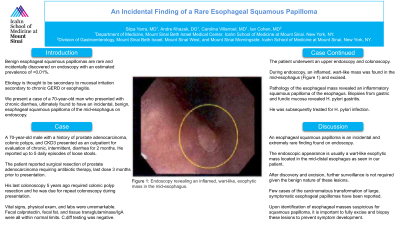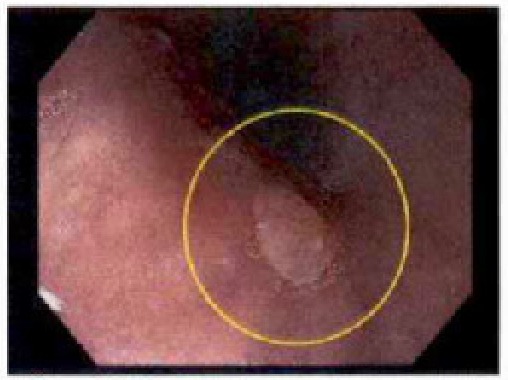Back


Poster Session D - Tuesday Morning
Category: Esophagus
D0227 - An Incidental Finding of a Rare Esophageal Squamous Papilloma
Tuesday, October 25, 2022
10:00 AM – 12:00 PM ET
Location: Crown Ballroom

Has Audio
- SY
Silpa Yarra, MD
Mount Sinai Beth Israel
New York, NY
Presenting Author(s)
Silpa Yarra, MD, Andre Khazak, DO, Carolina Villarroel, MD, Ian J. Cohen, MD
Mount Sinai Beth Israel, New York, NY
Introduction: Benign esophageal squamous papillomas are rare and usually incidental lesions discovered on endoscopy. The prevalence of these lesions are estimated to be less than 0.01%. Etiology has been controversial, however it has been thought to be caused by mucosal irritation secondary to chronic GERD or esophagitis. We present a case of a 70-year-old man who presented with chronic diarrhea who underwent EGD and colonoscopy found to have H. Pylori associated gastritis with an incidental finding of a rare, but benign, esophageal squamous papilloma in the mid-esophagus.
Case Description/Methods: A 70-year-old man with a medical history of prostate adenocarcinoma, colonic polyps, and CKD stage 3 presented to his outpatient gastroenterology appointment for evaluation of chronic diarrhea. The patient reported having intermittent diarrhea occurring about every 3 days for the past 2 months. He reported it occurred anywhere from 1 to 5 times a day. Patient stated he had recent surgeries for his prostate adenocarcinoma requiring him to take antibiotics, however his last antibiotic dose was 3 months prior to presentation. His last colonoscopy was 5 years ago where colonic polyps were removed, and he was told to have a repeat colonoscopy in 5 years. Vitals, physical exam, and labs were unremarkable. Fecal calprotectin, fecal fat, and tissue transglutaminase/IgA were all within normal limits. Clostridium difficile was also ruled out. Patient subsequently underwent an upper endoscopy and colonoscopy. Biopsies from upper endoscopy revealed H. Pylori associated gastritis in the gastric antral and fundic mucosa, which the patient was subsequently treated for. However, an inflamed, esophageal squamous papilloma was also incidentally found in the mid-esophagus and excised during the procedure.
Discussion: An esophageal squamous papilloma is an incidental and extremely rare finding found on endoscopy. The endoscopic appearance is usually a wart-like exophytic mass located in the mid-distal esophagus as seen in this patient’s upper endoscopy (Figure 1). They are usually excised when discovered and patients do not need further surveillance given the benign nature of these lesions. There have been a few reported cases of the carcinomatous transformation of large, symptomatic esophageal papillomas, however the small number of cases makes drawing any assumptions or conclusions difficult. Therefore, it is important to fully excise and biopsy esophageal squamous papillomas when found to prevent further symptoms from arising.

Disclosures:
Silpa Yarra, MD, Andre Khazak, DO, Carolina Villarroel, MD, Ian J. Cohen, MD. D0227 - An Incidental Finding of a Rare Esophageal Squamous Papilloma, ACG 2022 Annual Scientific Meeting Abstracts. Charlotte, NC: American College of Gastroenterology.
Mount Sinai Beth Israel, New York, NY
Introduction: Benign esophageal squamous papillomas are rare and usually incidental lesions discovered on endoscopy. The prevalence of these lesions are estimated to be less than 0.01%. Etiology has been controversial, however it has been thought to be caused by mucosal irritation secondary to chronic GERD or esophagitis. We present a case of a 70-year-old man who presented with chronic diarrhea who underwent EGD and colonoscopy found to have H. Pylori associated gastritis with an incidental finding of a rare, but benign, esophageal squamous papilloma in the mid-esophagus.
Case Description/Methods: A 70-year-old man with a medical history of prostate adenocarcinoma, colonic polyps, and CKD stage 3 presented to his outpatient gastroenterology appointment for evaluation of chronic diarrhea. The patient reported having intermittent diarrhea occurring about every 3 days for the past 2 months. He reported it occurred anywhere from 1 to 5 times a day. Patient stated he had recent surgeries for his prostate adenocarcinoma requiring him to take antibiotics, however his last antibiotic dose was 3 months prior to presentation. His last colonoscopy was 5 years ago where colonic polyps were removed, and he was told to have a repeat colonoscopy in 5 years. Vitals, physical exam, and labs were unremarkable. Fecal calprotectin, fecal fat, and tissue transglutaminase/IgA were all within normal limits. Clostridium difficile was also ruled out. Patient subsequently underwent an upper endoscopy and colonoscopy. Biopsies from upper endoscopy revealed H. Pylori associated gastritis in the gastric antral and fundic mucosa, which the patient was subsequently treated for. However, an inflamed, esophageal squamous papilloma was also incidentally found in the mid-esophagus and excised during the procedure.
Discussion: An esophageal squamous papilloma is an incidental and extremely rare finding found on endoscopy. The endoscopic appearance is usually a wart-like exophytic mass located in the mid-distal esophagus as seen in this patient’s upper endoscopy (Figure 1). They are usually excised when discovered and patients do not need further surveillance given the benign nature of these lesions. There have been a few reported cases of the carcinomatous transformation of large, symptomatic esophageal papillomas, however the small number of cases makes drawing any assumptions or conclusions difficult. Therefore, it is important to fully excise and biopsy esophageal squamous papillomas when found to prevent further symptoms from arising.

Figure: Figure 1. Esophageal Squamous Papilloma Appearance on Patient's Upper Endoscopy
Disclosures:
Silpa Yarra indicated no relevant financial relationships.
Andre Khazak indicated no relevant financial relationships.
Carolina Villarroel indicated no relevant financial relationships.
Ian Cohen indicated no relevant financial relationships.
Silpa Yarra, MD, Andre Khazak, DO, Carolina Villarroel, MD, Ian J. Cohen, MD. D0227 - An Incidental Finding of a Rare Esophageal Squamous Papilloma, ACG 2022 Annual Scientific Meeting Abstracts. Charlotte, NC: American College of Gastroenterology.
